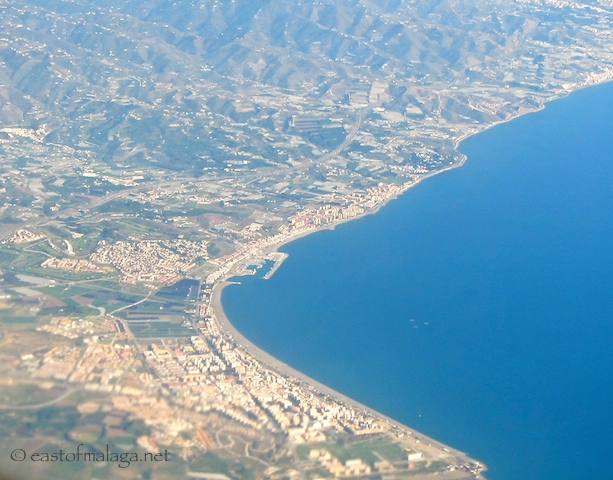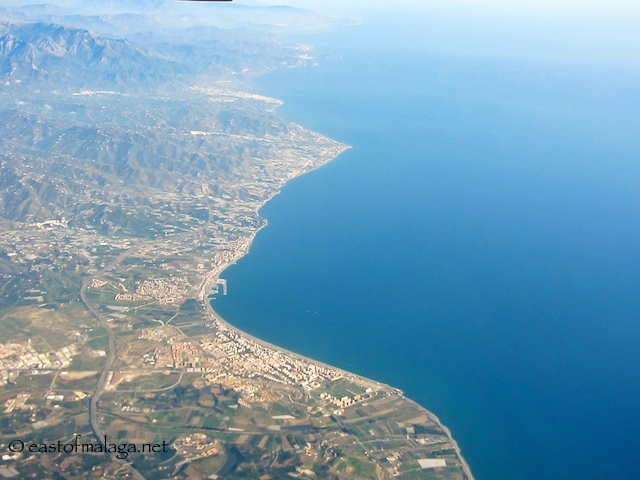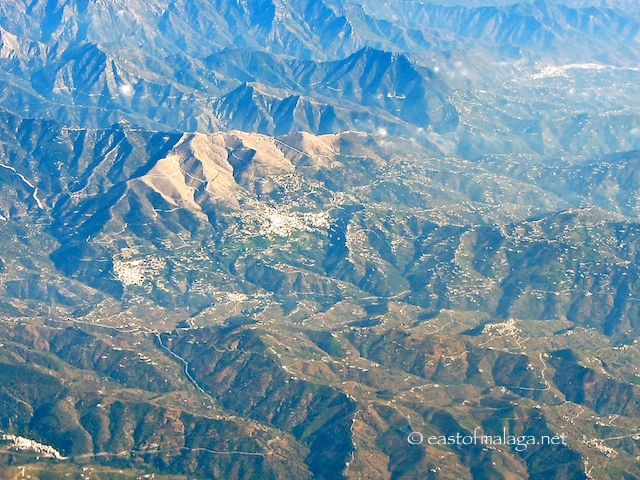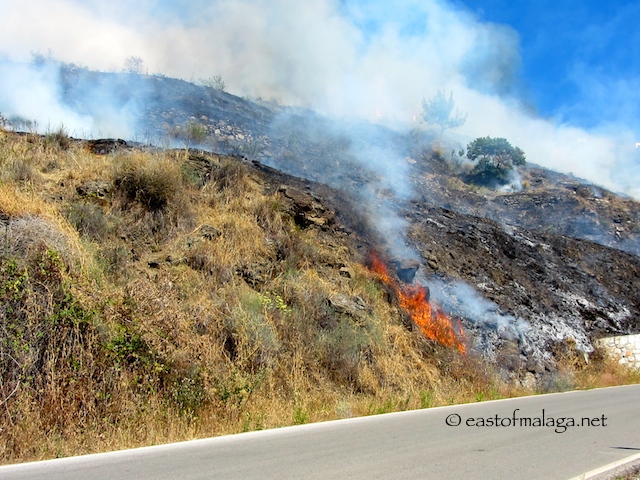
It’s always exciting when the first almond blossom appears on the trees in the garden, but when that day is also New Year’s Day, it’s even more special.
Happy New Year, everyone!
If you liked this post, you’ll LOVE these:

It’s always exciting when the first almond blossom appears on the trees in the garden, but when that day is also New Year’s Day, it’s even more special.
Happy New Year, everyone!
If you liked this post, you’ll LOVE these:

I love flying and whenever possible I’ll jump at the chance of a window seat. It’s fascinating to see the land below from a totally unique perspective and particularly if you know the area well, at ground level.
Last Thursday lunchtime I flew back to the UK to see friends and family for a few days. As is often the case, my plane took off from Málaga airport and headed out to sea before banking left to cross back over the coast of the Axarquía. From my window seat on the right-hand side of the plane, I had a bird’s-eye view, and the best and clearest view I have ever had.

We crossed the coast over Benajarafe, giving me a great view of the harbour and marina at Caleta de Vélez with Algarrobo Costa just above (and slightly to the right in the photo) and Torre del Mar below.

From the wider angle, you can also see the point of land sticking out which is where the lighthouse is at Torrox Costa, with the start of Nerja beyond.

As we continued to fly inland, Vélez-Málaga came into view and, if you look closely, you can just about see the motorway (Autovía del Mediterraneo) cutting across the landscape before Torre del Mar begins.

The white mountain village of Cómpeta was instantly recognisable, as the tops of the mountains above the village suffered and remain scarred by the devastating fire last summer.

We flew directly over the bare, pointless peak of La Maroma, the highest mountain in Málaga province – standing at an impressive 2065m (or 6775ft), and dominating the skyline of the Axarquía. You can clearly see the village of Canillas de Aceituno in the lee of La Maroma (towards the bottom right of the photograph).

And finally, after flying over Mount Maroma, we left the Axarquía region where the distinctive shape of the reservoir of Lake Bermejales came into view, and the town towards the bottom left of the photo is Alhama de Granada.
You might also enjoy:
 You might remember that towards the end of June last year, we had a large wildfire on the outskirts of my home village of Cómpeta. This event prompted me to write an article about what we should do about fire prevention and self protection in the event of a wildfire.
You might remember that towards the end of June last year, we had a large wildfire on the outskirts of my home village of Cómpeta. This event prompted me to write an article about what we should do about fire prevention and self protection in the event of a wildfire.
Yesterday afternoon, I was on my way home from Málaga when, just before the turn off to my house, I spotted a large plume of smoke, not far away. Instead of turning towards my home, I carried on up the road towards Cómpeta, and only about 750 metres further on came across a burning hillside.
It was quite surreal as there was no-one else around, yet clearly it appeared that the fire had been burning for at least some minutes as the whole hillside looked to be alight.
I drove past the fire, turned the car around and pulled to the side of the road to call the emergency services (the number to call in Europe is 112) to give the exact location of the fire.
There was nothing else I could do, and I didn’t want my car being in the way of the emergency services, so I took this short video (only about 7 seconds) and then headed home to spread the word.
The fire is not only by the side of the road, but look at the flare-up near the top right of the frame.
After only a couple of minutes I had posted on Twitter and onto my own East of Málaga Facebook page, where I know that lots of local people follow me. Within no time at all, that post had reached 6,000 people and had been shared 40 times – with lots of comments tagging others to let them know.
THAT’S THE POWER OF COMMUNITY and I am very proud of the community that has grown up around my East of Málaga blog.
So I’d like to say a great big THANK YOU to each and every one of you and, to those who don’t follow my Facebook page , I’d like to invite you to “Like” the page, click on “Get Notifications” and join in with the community.
I usually post a couple of times a day, and share many more photos over there.
As for the fire – well, I went back a couple hours later – after the helicopter had left, and the fire appeared to be largely out, though the fire fighters were still there, doing their job.
Well done, guys and THANK YOU!
Today, bringing a whole new meaning to the winter blues, on my East of Malaga Facebook page we are celebrating the “Málaga Blues”.
This is a series of photographs taken around Málaga province, showing skies, sea and doors in various shades of blue.
One of the best ways to cool down on a hot summer´s day is to take a walk along the Rio Chillar from Nerja. Unusually for Andalucía, this route is suitable for walking during June, July and August, as there is plenty of shade, plus the river to keep you cool.
Closer to Frigiliana in terms of distance, this mountain hamlet is a world away from the hoards of holiday-makers visiting the Costa del Sol. You can discover this delightful blue door in the Lost Village of El Acebuchal.
Held every year in August, the Málaga feria is one of the largest fairs in Spain with millions of people joining the fun throughout the week.
In 1979, a cave was discovered near to the Zafarraya Pass, with a subsequent archaeological dig unearthing the best preserved remains of Neanderthal man (radiometrically dating back 30000 years) ever found in Western Europe.
This house with it’s heavenly views can be found in the upper part of the white village of Frigiliana. There is no motor vehicle access up the steep streets to this part of the village, which remains largely how it must have looked hundreds of years ago, when the village was occupied by the Moors.
Last summer I had fun photographing the colourful sails of the catamarans at the sailing club in Torre del Mar.
Lying in the shadow of the largest mountain in the Axarquía region, there has been a settlement on the site of Canillas de Aceituno since the Moorish occupation in the 8th century, when the main industry was the growing of mulberry trees for silk production.
My final image is from my home village of Cómpeta, showing a pretty balcony, filled with flowers, against the deep blue painted windows as their background.
El Acebuchal isn’t so much a village as a 17th century hamlet within the unspoilt mountains and natural park of Sierra Tejeda, Almijara and Alhama.
Situated close to the border of the provinces of Granada and Málaga and coming under the control of Cómpeta, El Acebuchal is actually nearer to Frigiliana in terms of distance – yet a world away from the hoards of holiday-makers visiting the Costa del Sol.
The name comes from the Arabic “acebuche” meaning olive, and even though we know of its existence since 17th century, it is thought to have been inhabited long before then.
El Acebuchal was an important staging post on the ancient mule-trading routes between Competa, Frigiliana, Nerja and the inland city of Granada.
Fresh fish caught on the coast and locally grown crops including tomatoes and raisins were traded for chickpeas, wheat, lentils and other goods not easily available in the nearby mountains.
Life was hard for the inhabitants, as it was in most of rural Andalucía, but became even more difficult when they were caught between the Franco regime and guerrillas in the aftermath of the Spanish Civil War. Authorities had long suspected the villagers of supporting Republican rebels hiding out in the mountains, by providing them with food and refuge. In truth, the villagers were literally caught in the crossfire, and hassled from both sides.
In the summer of 1948, the villagers paid a heavy price for their isolated location in the mountains when the Guardia Civil ordered that El Acebuchal be cleared of its 200 inhabitants, who were forced to flee, leaving behind their homes, belongings and livestock.
The abandoned mountain hamlet soon fell into disrepair and eventually into ruins, becoming known locally as “The Lost Village” or “Pueblo el Fantasmas” – The Village of Ghosts.
Fifty years later in 1998, Antonio García Sánchez, son of one of the original villagers, returned with his wife, Virtudes and family to restore a couple of houses in the village. Once these were completed, they rebuilt a further five houses and the tavern when they noticed an increase of rural tourism in the area.
People were starting to return to El Acebuchal.
This family’s adventure became contagious as other former residents turned their attention back to their old family homes to begin their restoration, so that today, all 36 houses, the chapel, tavern and cobblestone streets have been returned to how they once were.
If you head to El Acebuchal and discover the tavern during the morning, you will probably find Antonio and some of his family gathered on the shady terrace opposite, performing some of their duties. The tavern restaurant serves dishes appropriate for the mountain environment: choto (kid), lamb, wild boar, rabbit and venison, with delicious home-made cakes and bread.
Step inside the tavern and you will find the walls proudly lined with old photos of El Acebuchal and its former residents. Whenever I visit, I always find myself lingering a while, trying to imagine what life must have been like for these people.
With only a handful of permanent residents, most people you see around the streets are visitors, hikers or holidaymakers staying in one of the village rental properties.
The countryside near to the isolated hamlet is almost deserted except for the crumbling ruins of long-abandoned cortijos. There are plunging ravines, tinkling streams, mountain slopes covered with pine trees and the rocky crags of the mountain tops reaching up to the blue skies above.
This area is ideal for visitors who want to get away from it all …. and you can certainly do that in El Acebuchal as there is no telephone reception, no shops, credit cards or internet.
Rural tourism has breathed life back into the village which has risen like a phoenix from the ashes.
There are main two routes to El Acebuchal. You can get there from the Cómpeta-Torrox road (A7207), where you turn off near to the Km 8 road marker. Follow the direction signs for El Acebuchal. Here you will face a 6.5 kilometre un-made mountain track to the village. It’s not for the faint-hearted as there are no barriers, but it’s certainly drivable – and you don’t need a 4-wheel drive to do it. Along the way you will drive through a stream and see spectacular scenery. It’s quite an adventure!
Alternatively, the more popular and shorter route is from the village of Frigiliana. Take the scenic back-road towards Torrox, and after two kilometres you will see the turn-off sign to Acebuchal on your right. This road is asphalted – except for an easy 1500 metre section near to the village.